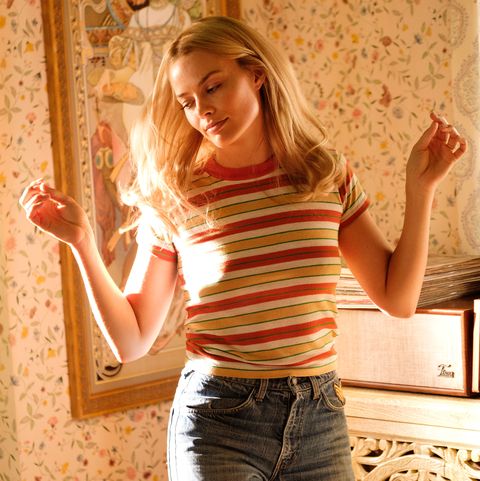
ANDREW COOPER/Courtesy Columbia Pictures
“Now, what you’ve been waiting for,” a grainy figure announces, framed inside a 1960s television set. Cue the Manson followers driving up to Sharon Tate’s (Margot Robbie) home, packing heat.
As Once Upon a Time… in Hollywood nears its conclusion, Quentin Tarantino uses the announcer to speak to his audience, promising them that at last, the bloodshed will begin. Ever since Tarantino fans heard that the movie would feature Sharon Tate and members of the Manson cult, it was assumed that the gruesome crime would be reenacted onscreen, styled with the director's usual cartoonish gore.
By this time, Tarantino had dangled the promised scene in front of his audience for well over two hours—making viewers wait for it like Cliff Booth (Brad Pitt) makes his pit bull sit tight for dinner. And during that substantial runtime, Sharon Tate didn't really talk. She mostly serves as a plot device—breaking up Rick Dalton (Leonardo DiCaprio) and Booth’s buddy comedy-slash-midlife crisis with a quick smile, reminding the audience that the plot was about to get a whole lot more twisted.
Except that it didn't. Well, there was quite a savage sequence inside Dalton’s house, as an acid-tripping Booth took on one Manson follower at a time. His pit bull pulled his weight, too, and Dalton even got to torch someone with a flame-thrower. But Tarantino chose to rewrite history, having the Manson “family” fatefully mistake Dalton’s house for Tate’s, and never make it out again. Tarantino’s Tate tease was just that—a tease.
The “twist” ending is a happy one, of course. In this alternate universe, Tate gets to raise her child; her friends will enjoy long lives; Hollywood’s innocence won’t be shattered, at least for a while longer. Plus, we all were treated to the singular catharsis of watching the brutality that the Manson crew became synonymous with get turned back around on them.
It's a historical fairy tale, but it's also a meditation on Tarantino's own penchant for gore, and the ethics of screening such unadulterated violence. With the simple line "and now, what you've been waiting for," the director acknowledges that some of his fans at least—and maybe all of us—have a sick fascination with violence.
It’s like what Marvin Schwarzs (Al Pacino), a moneyed movie lover, tells Dalton about his bloody films. He says something to the effect of, “I love that stuff. The killing, the shooting.” (Onscreen, it cuts to Dalton in a Western, nailing enemies with a rifle; then places him in a Nazi operation, where he takes down the Germans with a flamethrower.) Dalton nods, laughing—if with a bit of hesitation.
Neither of Dalton’s films is a far cry from a real Tarantino flick. The former is reminiscent of The Hateful Eight or Django Unchained; the latter mirrors the end of Inglorious Basterds, in which Hitler, Goebbels, and more die in a burning theater.
Even if the director is intending to leverage the onscreen brutality only as a high-minded critique—which, quite frankly, he probably isn’t—he’d be satisfying some of his violence-hungry fans’ desires. Some people just love the killing, the shooting. Not that it'll stop Tarantino from pumping it out.


Tidak ada komentar:
Posting Komentar